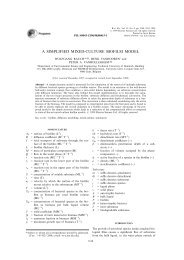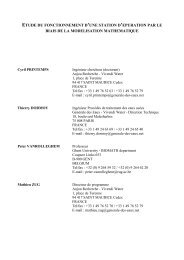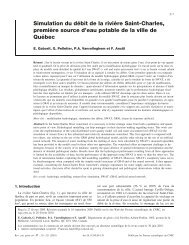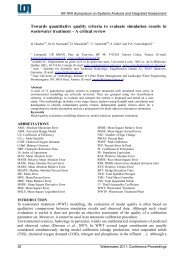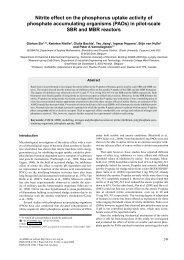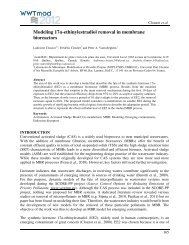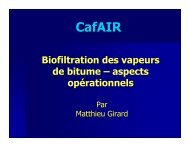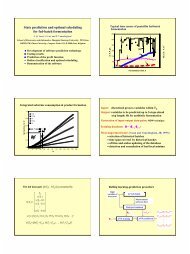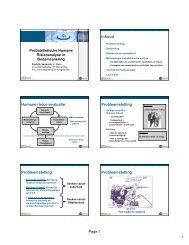Optimal control of the penicillin G fed-batch fermentation: An ...
Optimal control of the penicillin G fed-batch fermentation: An ...
Optimal control of the penicillin G fed-batch fermentation: An ...
Create successful ePaper yourself
Turn your PDF publications into a flip-book with our unique Google optimized e-Paper software.
14 J. F. VAN IMPE ETAL.corresponding parameters are in general time-varying. Secondly, up till now <strong>the</strong>re is a lack <strong>of</strong>reliable sensors suited to real-time monitoring <strong>of</strong> process variables which are needed inadvanced <strong>control</strong> algorithms. Therefore <strong>the</strong> earliest attempts at <strong>control</strong> <strong>of</strong> a biotechnologicalprocess used no model at all. Successful state trajectories from previous runs which had beenstored in <strong>the</strong> process computer were tracked using open-loop <strong>control</strong>. Many industrial<strong>fermentation</strong>s are still operated using this method.During <strong>the</strong> last two decades, two trends for <strong>the</strong> design <strong>of</strong> monitoring and <strong>control</strong> algorithmsfor <strong>fermentation</strong> processes have emerged. ' In a jrst approach <strong>the</strong> difficulties in obtaining anaccurate ma<strong>the</strong>matical process model are ignored. In numerous papers classical methods (e.g.Kalman filtering, optimal <strong>control</strong> <strong>the</strong>ory, etc.) are applied under <strong>the</strong> assumption that <strong>the</strong> modelis perfectly known. Owing to this oversimplification, it is very unlikely that a real-lifeimplementation <strong>of</strong> such <strong>control</strong>lers - very <strong>of</strong>ten this implementation is already hampered bye.g. monitoring problems - would result in <strong>the</strong> predicted simulation results. In a secondapproach <strong>the</strong> aim is to design specific monitoring and <strong>control</strong> algorithms without <strong>the</strong> need fora complete knowledge <strong>of</strong> <strong>the</strong> process model, using concepts from e.g. adaptive <strong>control</strong> andnon-linear linearizing <strong>control</strong>. A comprehensive treatment <strong>of</strong> <strong>the</strong>se ideas can be found inReference 2 and <strong>the</strong> references cited <strong>the</strong>rein.We have shown how to combine <strong>the</strong> best <strong>of</strong> both trends into one unifying methodology foroptimization <strong>of</strong> biotechnological processes: optimal adaptive <strong>control</strong>. 3*4 This is motivated asfollows. Model-based optimal <strong>control</strong> studies provide a <strong>the</strong>oretical realizable optimum.However, <strong>the</strong> real-life implementation will fail in <strong>the</strong> first place owing to modellinguncertainties. On <strong>the</strong> o<strong>the</strong>r hand, model-independent adaptive <strong>control</strong>lers can be designed, but<strong>the</strong>re is a priori no guarantee for at least suboptimality <strong>of</strong> <strong>the</strong> results obtained. The gapbetween <strong>the</strong> two approaches is bridged in two steps. First, heuristic <strong>control</strong> strategies aredeveloped with nearly optimal performance under all conditions. These suboptimal <strong>control</strong>lersare based on biochemical knowledge concerning <strong>the</strong> process and on a careful ma<strong>the</strong>maticalanalysis <strong>of</strong> <strong>the</strong> optimal <strong>control</strong> solution. In a second step, implementation <strong>of</strong> <strong>the</strong>se pr<strong>of</strong>iles inan adaptive model-independent way combines excellent robustness properties with nearlyoptimal performance.As an example, we consider in this paper <strong>the</strong> development <strong>of</strong> a heuristic substrate feed rate<strong>control</strong>ler for <strong>the</strong> <strong>penicillin</strong> G <strong>fed</strong>-<strong>batch</strong> <strong>fermentation</strong> process, based on ma<strong>the</strong>matical andmicrobial insights. There are at least two unstructured models available in <strong>the</strong> literature thatallow for <strong>the</strong> optimization <strong>of</strong> <strong>the</strong> final <strong>penicillin</strong> amount with respect to <strong>the</strong> glucose feedingrate: <strong>the</strong> model <strong>of</strong> Heijnen et al. and <strong>the</strong> model <strong>of</strong> Bajpai and ReuD. The latter has beenanalysed in References 4 and 7. The analysis in this paper is based on <strong>the</strong> unstructuredma<strong>the</strong>matical model proposed by Heijnen et al. ' For <strong>the</strong> second step <strong>of</strong> <strong>the</strong> above approach,i.e. <strong>the</strong> adaptive implementation, we refer to References 3 and 4.Nowadays <strong>penicillin</strong> G is an almost common antibiotic; never<strong>the</strong>less <strong>the</strong> <strong>fermentation</strong>technology and <strong>the</strong> ma<strong>the</strong>matical description <strong>of</strong> <strong>the</strong> production process are still subjects <strong>of</strong>interest. The optimization <strong>of</strong> product formation during <strong>fed</strong>-<strong>batch</strong> <strong>fermentation</strong> as a part <strong>of</strong>total process <strong>control</strong> has gained renewed attention. *The category <strong>of</strong> secondary metabolites includes a large number <strong>of</strong> extremely valuablecompounds whose mass production has revolutionized public health in modern society. In thispaper <strong>the</strong> example <strong>of</strong> <strong>penicillin</strong> G <strong>fed</strong>-<strong>batch</strong> <strong>fermentation</strong> is only used as a vehicle forpresenting <strong>the</strong> basic ideas, methodology and results obtained. This <strong>fermentation</strong> process canbe considered representative for <strong>the</strong> whole class <strong>of</strong> processes with secondary metabolite^.^The paper is organized as follows. Section 2 presents <strong>the</strong> original model <strong>of</strong> Heijnen et al.and <strong>the</strong> modifications to make it suitable for standard optimal <strong>control</strong>, toge<strong>the</strong>r with <strong>the</strong>



